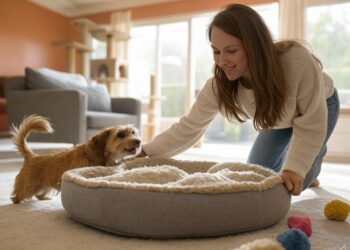To any loving pet owner, their dogs are not just pets they are a part of the family. So you will always do your best to care for them, even if they have disability or mobility issues. If your dog suffers from canine hip dysplasia or any other condition that makes it difficult for them to get around, this post is written with you in mind.
We are going to share seven simple but effective tips you can use to help your dog cope with the pain and loss of mobility they are suffering with. Now we will look at each point from the list in detail and see if they make sense for your pet pooch.
Invest in a Good Quality Dog Bed
This one can be a game-changer. Most dogs sleep on average twelve to fourteen hours per day.
Some breeds, larger dogs, older dogs, and dogs with disabilities may need even more sleep than that.
So it is really important that you do your best to give them a good bed (don’t worry we will share a tip for if you are on a tight budget).
Reading Suggestions: Dog Breeding 101 – Answers To Your Questions
When looking for a dog bed for a disabled dog there are two things you need to consider.
- Will it support your dog’s joints?
- Is it good enough quality to last?
Will it support your dog’s joints? The word “orthopedic” gets used a lot by dog bed manufacturers but what it actually means is that the bed fully supports all your dog’s joints.
Keeping them up off the cold hard floor and not creating any painful pressure points.
Is it good enough quality to last? The bed has to be able to continually support your dog. It is not good if after a few months all the cushioning goes out of the bed.
What about if you are on a really tight budget? Your goal should be to get plenty of cushioning under your dog.
So even if you have to buy a really cheap dog bed, you can then put foam, blankets or some other sort of padding underneath it for extra support.
Use Heat Therapy to Ease Pain and Increase Joint Mobility
If you apply gentle heat to a dog’s muscles they will relax, which will then loosen their tight joints.
This then reduces pain and increases mobility. While it is only temporarily effective it can have a really powerful impact.
The easiest way to do this is buy a heating pad made especially for dogs; make sure it is chew proof and waterproof.
You can either lay the pad on a comfy piece of floor or put it inside their bed for fast acting relief from their disability.
(It is also worth remembering that should take extra care during winter to make your dog gets plenty of heat therapy to soothe their joints).
For Serious Conditions Consider a Doggy Wheelchair
If your dog has such a serious disability that they struggle to walk, you could build or buy them a wheelchair.
Yes, dog wheelchairs exist and they are amazing!
As long as the dog has use of either its two front or rear legs they will be able to use one and get a whole new lease of life from doing so.
Short Regular Walks Can Help
If possible it is important to keep your dog’s exercising, even if it is only for very short, very slow walks, it will still help.
Not only will it help loosen joints and maintain muscle mass but as long as the pain isn’t too much it will also help improve the mental well-being which is just as important as their physical.
The key points to remember here are that more frequent short walks are better than one long ones, also to let the dog set the pace and avoid difficult terrain.
Reading Suggestion: Happy Dog Food Review and Recommendations for 2021
Try Giving Your Dog Some Supplements
While the efficacy of these supplements is still under some debate, many people give their dogs glucosamine, chondroitin and omega-3 fatty acids (fish oil).
They are relatively cheap, they can’t harm your dog and they may help.
So why not give them a go, along with your regular dog food and see if there are any benefits?
Love ALWAYS Helps
Dogs need love just as much as humans do, love, cuddles, strokes, play time, attention, these are vital to helping your disabled dog stay as happy and healthy as possible.
Keep In Touch with Your Vet
It is important for all dog owners to keep in touch with their vet to make sure that their dog has no underlying health conditions. But this is even more important for owners of disabled dogs.
You need to find a good vet, who understands how much you love your dog and does everything they can to keep them happy and healthy for as long as possible.
That’s it for this post, I hope that some or maybe even all of these tips have given you some inspiration for ways to improve your dog’s life.
Image Credits: labsafeharbor







